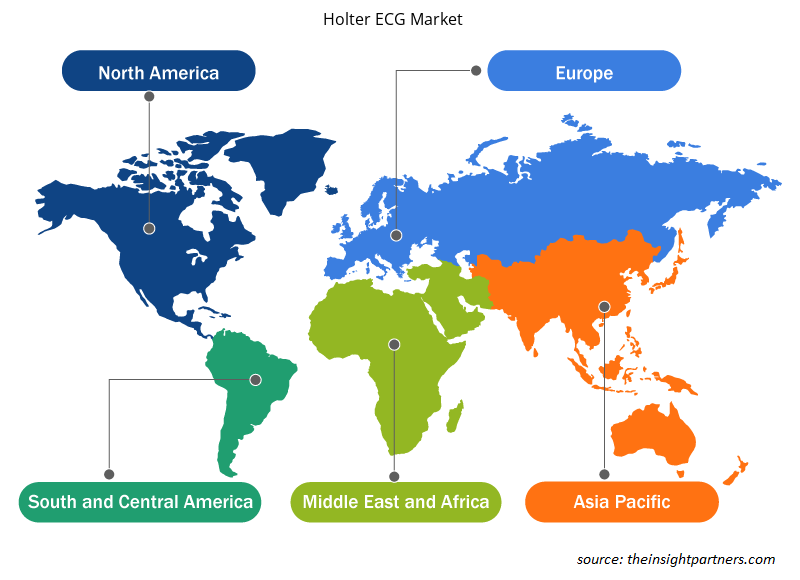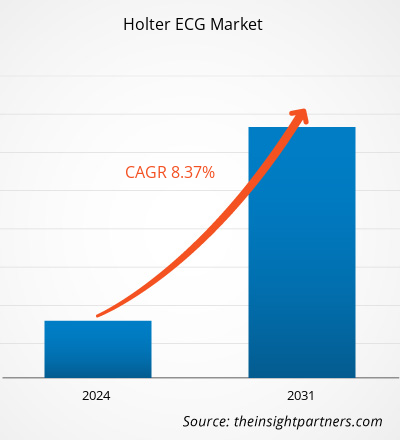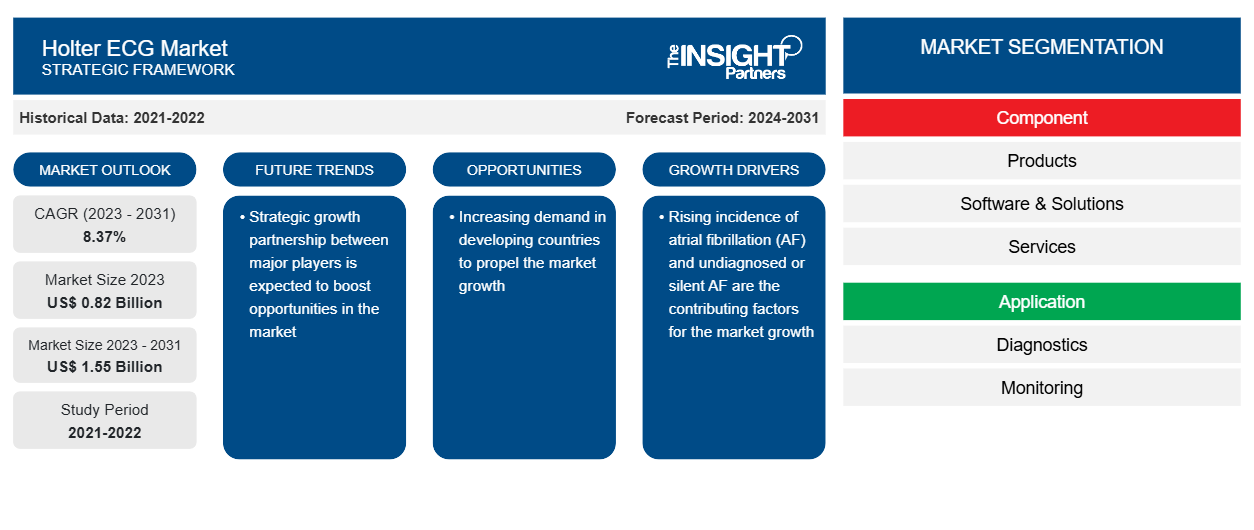预计到 2031 年,Holter ECG 市场规模将从 2023 年的 8.2 亿美元增至 15.5 亿美元。预计 2023-2031 年市场复合年增长率将达到 8.37%。推动市场增长的主要因素是心血管疾病 (CVD) 患病率上升和老龄人口增加,这些因素推动了市场的增长。然而,缺乏熟练的专业人员导致 Holter ECG 分析不准确,从而阻碍了市场增长。
动态心电图市场分析
它是一种便携式心电图 (ECG),称为 Holter 监护仪。房颤 (AF) 发病率上升以及未确诊或无症状房颤是导致 Holter ECG 需求增加的因素。此外,患有结构性心脏病 (SHD) 的老年人口基数高也加速了对 Holter ECG 的需求,从而推动了整体市场增长
动态心电图市场概览
全球许多经济体,包括美国、英国、加拿大、日本、中国、印度和韩国,都在医疗服务和设施现代化方面取得了重大进步。因此,许多国家的人民预期寿命都有所增加,老年人口数量也随之增加。世界卫生组织在 2018 年 2 月报告称,老龄人口比例将从 2015 年的 12% 上升到 2050 年的 22%。此外,美国人口普查局的一项研究预测,到 2060 年,美国 65 岁及以上人口将超过 9800 万,高于 2016 年的 4600 万。在此期间,他们的人口比例将从约 15% 上升到 24% 左右。根据联合国世界人口老龄化组织发布的另一份报告,2017 年欧洲 60 岁以上人口比例居世界首位(即 25%)。此外,到 2050 年,除非洲外,各大洲至少 25% 的人口将达到 60 岁或以上。而且,这一增长中不到 80% 将来自发展中国家和贫困国家。
定制此报告以满足您的需求
您可以免费定制任何报告,包括本报告的部分内容、国家级分析、Excel 数据包,以及为初创企业和大学提供优惠和折扣
- 获取此报告的关键市场趋势。这个免费样品将包括数据分析,从市场趋势到估计和预测。
动态心电图市场驱动因素和机遇
心血管疾病 (CVD) 病例增加,推动动态心电图需求
全球市场见证了 Holter 心电图监测仪的显著发展,帮助医生和患者采用新方法来管理室性心律失常、房性心律失常和心室房颤动等疾病。Holter 监测是一种非侵入性、更安全、更有效的患者监测方式。根据世界卫生组织 (WHO) 的数据,每年约有 3000 万人中风。根据美国心脏协会的数据,美国几乎一半的成年人患有某种类型的心血管疾病。此外,到 2035 年,预计超过 1.3 亿人(即 45.1% 的美国人口)将患有某种类型的心血管疾病。
欧洲心脏病学会报告称,房颤患者中风风险高出五倍,欧洲 20-30% 的中风病例是由房颤引起的。根据欧洲心脏病学会 2016 年的一项研究,欧盟约有 760 万名 65 岁或以上的成年人患有房颤。到 2060 年,这一数字预计将上升 89%,达到约 1440 万。根据 2019 年 Biosense Webster 研究“超越负担:房颤对亚太地区的影响”,亚太地区约有 1600 万人患有房颤,预计到 2050 年这一数字将上升至约 7200 万。此外,数据表明老年人和中年人患此病的几率更高。预先监测和预先诊断有助于预防大多数心血管疾病。心律失常或心跳不规律也可以通过及时检测来预防。由于心律失常监测设备可以挽救有心脏骤停风险的患者,因此对这些设备的需求日益增长。因此,医疗保健行业投资于更好的医疗设施,并采用尖端技术来提供更好的医疗服务。这增加了对 Holter 心电图监测器等监测设备的需求。Holter 心电图被可能接触导致心血管疾病的变量的人群广泛使用,以降低与心血管疾病相关的风险。推动 Holter 心电图监测器需求的主要因素之一是它能够连续 24-48 小时记录心脏的电活动 (ECG),这对于安全诊断和治疗控制必不可少。
发展中经济体尚未开发的潜力——动态心电图市场的机会
预计随着心血管疾病诊断需求的不断增长,Holter ECG 的销量将会增加。知名行业参与者通过扩大供应链和提高生产能力来提高其在发展中经济体的市场份额。对于重要的 Holter ECG 制造商来说,韩国、墨西哥、巴西和印度等新兴市场预计将在未来几年呈现发展前景。心血管疾病的高发病率、庞大的患者群体、医疗基础设施的进步、医疗旅游的兴起以及可支配收入的增加都是促成因素。
由于法规和数据合规要求相对较低,亚太地区已成为一个商业友好且适应性强的地区。随着美国和欧洲市场的成熟,知名企业正将重点转向新兴国家市场。新兴国家对生命科学领域和健康研究的高投资是升级这些国家最新技术的重要因素。反过来,这一因素又支持了人们对心血管疾病诊断的倾向。
动态心电图市场报告细分分析
有助于得出动态心电图市场分析的关键部分是组件、应用、指示、渠道。
- 根据组件,动态心电图市场分为产品、软件和解决方案、服务和配件。产品部分在 2023 年占据了更高的市场份额。
- 根据应用,市场分为诊断和监控。
- 根据适应症,市场分为心房颤动 (AF)、心脏骤停、安装起搏器的患者等。
- 根据渠道,市场分为 3 通道心电图系统、5、6 和 7 通道心电图系统、12 通道心电图系统等。
动态心电图市场份额按地区分析
动态心电图市场报告的地理范围主要分为五个区域:北美、亚太、欧洲、中东和非洲、南美/南美和中美。
北美 Holter 心电图市场分为美国、加拿大和墨西哥。心电图领域技术进步产品的采用率不断提高以及房颤患病率的不断上升预计将加速 Holter 心电图市场的增长。此外,大型医疗保健企业的存在以及医院和家庭护理环境中 Holter 心电图的使用率不断提高,正在推动该地区市场的发展。
美国是全球最大的动态心电图市场。市场的增长归因于产品开发的增加和政府对加强心脏病治疗的支持。此外,心血管疾病发病率和风险的增加也推动了美国市场的增长。
心律失常会引起胸痛和昏厥,并可能导致中风或心源性猝死。据美国疾病控制与预防中心 (CDC) 估计,到 2030 年,美国将有 1210 万人患有心房颤动 (AF)。据 CDC 称,心血管疾病是美国女性和男性以及大多数种族和族裔群体死亡的主要原因之一。根据给出的事实,每 5 人中就有 1 人死于心脏病,即 2020 年约有 697,000 名美国人死于心脏病。由于心血管疾病的风险不断增加,政府和私人机构制定了各种计划。市场参与者采用有机和无机战略来开发市场。例如,2021 年 5 月,OSI Systems, Inc. 的一个部门 Spacelabs Healthcare 推出了 Lifescreen Pro 事件筛查系统,以准确诊断心律失常。此外,该国还有几家医院、超级专科医院,提供心血管疾病的诊断和治疗服务。该国的医疗中心提供融入人工智能和其他高科技技术的设施。该国的医院还提供远程患者监控。因此,由于上述因素,市场在预测期内可能会大幅增长。
动态心电图市场区域洞察
Insight Partners 的分析师已详细解释了预测期内影响 Holter ECG 市场的区域趋势和因素。本节还讨论了北美、欧洲、亚太地区、中东和非洲以及南美和中美洲的 Holter ECG 市场细分和地理位置。

- 获取 Holter ECG 市场的区域特定数据
动态心电图市场报告范围
| 报告属性 | 细节 |
|---|---|
| 2023 年的市场规模 | 8.2亿美元 |
| 2031 年市场规模 | 15.5亿美元 |
| 全球复合年增长率(2023 - 2031) | 8.37% |
| 史料 | 2021-2022 |
| 预测期 | 2024-2031 |
| 涵盖的领域 | 按组件
|
| 覆盖地区和国家 | 北美
|
| 市场领导者和主要公司简介 |
|
动态心电图市场参与者密度:了解其对业务动态的影响
动态心电图市场正在快速增长,这得益于终端用户需求的不断增长,这些需求源于消费者偏好的不断变化、技术进步以及对产品优势的认识不断提高等因素。随着需求的增加,企业正在扩大其产品范围,进行创新以满足消费者的需求,并利用新兴趋势,从而进一步推动市场增长。
市场参与者密度是指在特定市场或行业内运营的企业或公司的分布情况。它表明在给定市场空间中,相对于其规模或总市场价值,有多少竞争对手(市场参与者)存在。
在 Holter ECG 市场运营的主要公司有:
- BPL 医疗技术
- 福田电子
- 通用电气公司
- 荷兰皇家飞利浦公司
- 日本光电公司
- OSI 系统公司
免责声明:上面列出的公司没有按照任何特定顺序排列。

- 获取 Holter ECG 市场顶级关键参与者概览
动态心电图市场新闻和最新发展
通过收集主要和次要研究后的定性和定量数据来评估动态心电图市场,其中包括重要的公司出版物、协会数据和数据库。以下是市场创新、业务扩展和战略发展情况的列表:
- 2022 年 1 月,荷兰皇家飞利浦公司推出了首个用于分散临床试验的全套服务、居家、12 导联心电图 (ECG) 解决方案。该临床级解决方案是该公司心脏监测产品组合中最先进的以患者为中心的心电图产品,将与临床、现场心电图相当的数据读数与飞利浦领先的基于云的数据收集和分析服务相结合。(来源:飞利浦公司新闻稿)
动态心电图市场报告覆盖范围和交付成果
“Holter ECG 市场规模和预测(2021-2031 年)”报告对市场进行了详细分析,涵盖以下领域:
- 范围涵盖的所有主要细分市场的全球、区域和国家层面的 Holter ECG 市场规模和预测
- 市场动态,如驱动因素、限制因素和关键机遇
- 动态心电图市场趋势
- 详细的 PEST/波特五力分析和 SWOT 分析
- 动态心电图市场分析涵盖主要市场趋势、全球和区域框架、主要参与者、法规和最新市场发展
- 动态心电图行业格局和竞争分析,包括市场集中度、热图分析、知名企业和最新发展
- 详细的公司简介
- 历史分析(2 年)、基准年、预测(7 年)及复合年增长率
- PEST和SWOT分析
- 市场规模、价值/数量 - 全球、区域、国家
- 行业和竞争格局
- Excel 数据集
近期报告
客户评价
购买理由
- 明智的决策
- 了解市场动态
- 竞争分析
- 客户洞察
- 市场预测
- 风险规避
- 战略规划
- 投资论证
- 识别新兴市场
- 优化营销策略
- 提升运营效率
- 顺应监管趋势





















 获取免费样品 - 动态心电图市场
获取免费样品 - 动态心电图市场